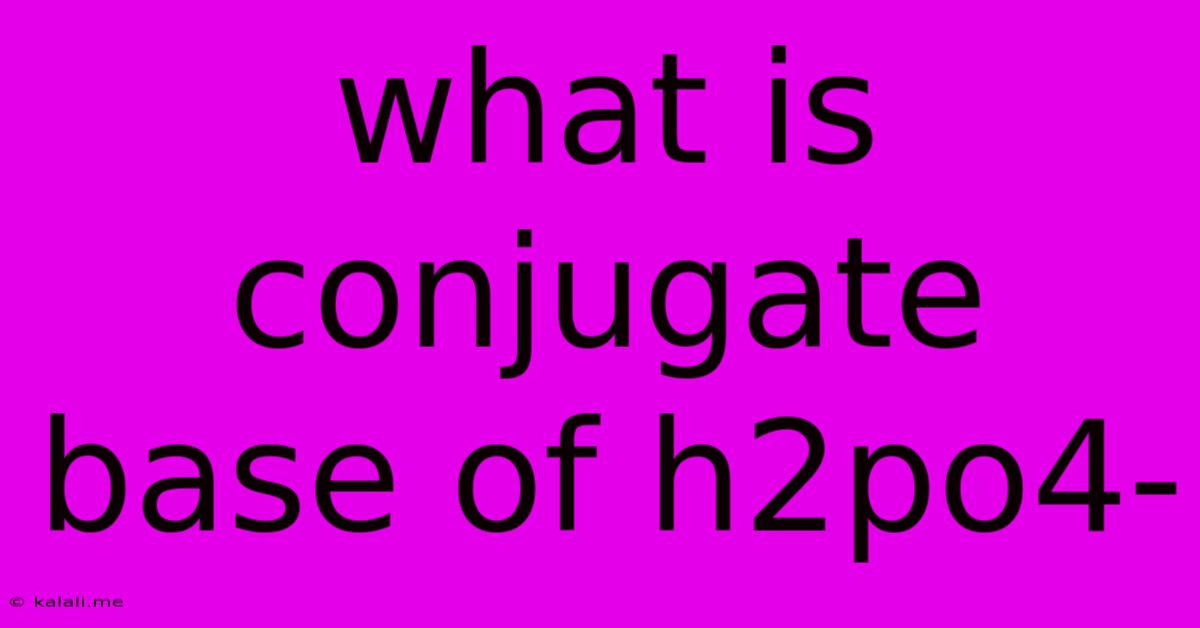What Is Conjugate Base Of H2po4-
Kalali
Jun 16, 2025 · 3 min read

Table of Contents
What is the Conjugate Base of H₂PO₄⁻? Understanding Acids, Bases, and Conjugate Pairs
Understanding conjugate acid-base pairs is fundamental to grasping acid-base chemistry. This article will delve into the concept, specifically addressing the question: what is the conjugate base of H₂PO₄⁻? We'll explore the definition of conjugate bases, how to identify them, and the relevance of this concept in various chemical contexts.
What are Conjugate Acid-Base Pairs?
According to the Brønsted-Lowry theory of acids and bases, an acid is a proton (H⁺) donor, and a base is a proton acceptor. A conjugate acid-base pair consists of two species that differ by a single proton. When an acid donates a proton, it forms its conjugate base. Conversely, when a base accepts a proton, it forms its conjugate acid.
Identifying the Conjugate Base of H₂PO₄⁻
H₂PO₄⁻, the dihydrogen phosphate ion, acts as an acid because it can donate a proton. To find its conjugate base, we simply remove one proton (H⁺) from the molecule. This leaves us with:
HPO₄²⁻ (monohydrogen phosphate ion)
Therefore, the conjugate base of H₂PO₄⁻ is HPO₄²⁻.
Understanding the Reaction
This transformation can be illustrated with a simple reaction, for example, with water:
H₂PO₄⁻(aq) + H₂O(l) ⇌ HPO₄²⁻(aq) + H₃O⁺(aq)
In this reaction, H₂PO₄⁻ acts as an acid, donating a proton to water (acting as a base). The resulting HPO₄²⁻ is the conjugate base, and H₃O⁺ (hydronium ion) is the conjugate acid of water.
The Importance of Conjugate Bases
Understanding conjugate bases is crucial for several reasons:
- Predicting reaction outcomes: Knowing the conjugate base helps predict the equilibrium position of acid-base reactions and the relative strengths of acids and bases. A stronger acid will have a weaker conjugate base, and vice versa.
- Buffer solutions: Buffer solutions, which resist changes in pH, are often composed of a weak acid and its conjugate base (or a weak base and its conjugate acid). The H₂PO₄⁻/HPO₄²⁻ pair is a common example of a buffer system used in biological systems.
- Titration curves: Conjugate bases play a significant role in determining the shape and equivalence point of titration curves.
- Solubility and complex formation: The formation of conjugate bases can influence the solubility of certain compounds and the formation of metal complexes.
Beyond H₂PO₄⁻: Expanding the Concept
The principle of conjugate acid-base pairs extends to many other molecules and ions. For instance, the conjugate base of carbonic acid (H₂CO₃) is bicarbonate (HCO₃⁻), and the conjugate base of acetic acid (CH₃COOH) is acetate (CH₃COO⁻). Identifying conjugate pairs is a fundamental skill in chemistry, enabling a deeper understanding of acid-base reactions and their implications.
This understanding of conjugate bases, exemplified by the H₂PO₄⁻/HPO₄²⁻ pair, is vital for anyone studying chemistry, particularly in areas like biochemistry and analytical chemistry. The ability to identify and understand the role of conjugate bases is key to solving various chemical problems and interpreting experimental results.
Latest Posts
Latest Posts
-
What Is The Tangent Of 90 Degrees
Jun 16, 2025
-
The Study Of The Earth Is Called
Jun 16, 2025
-
What Is The Least Common Multiple Of 26 And 39
Jun 16, 2025
-
Which Of The Following Is Chemical Change
Jun 16, 2025
-
Atoms Of The Same Element Having Different Numbers Of Neutrons
Jun 16, 2025
Related Post
Thank you for visiting our website which covers about What Is Conjugate Base Of H2po4- . We hope the information provided has been useful to you. Feel free to contact us if you have any questions or need further assistance. See you next time and don't miss to bookmark.